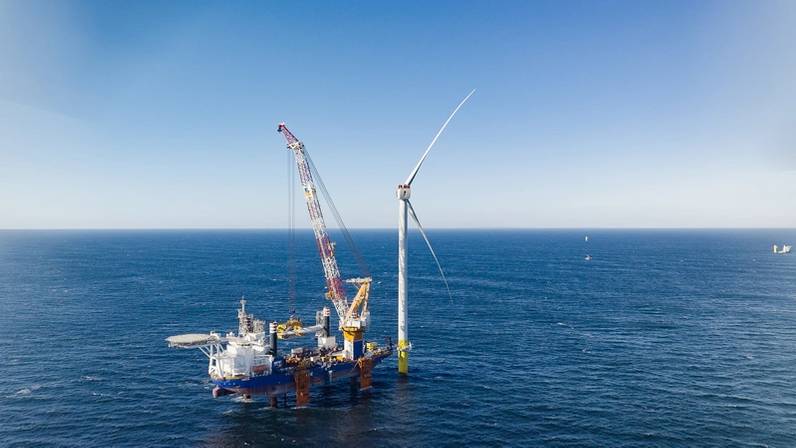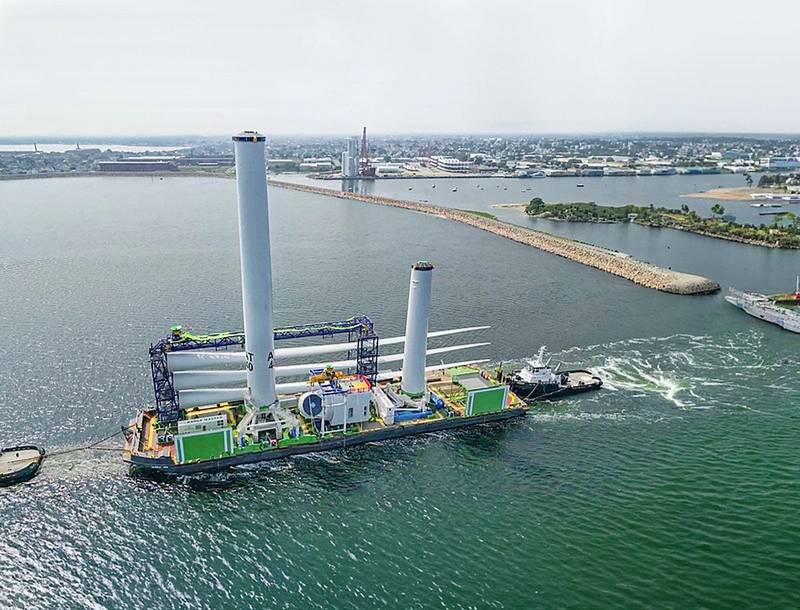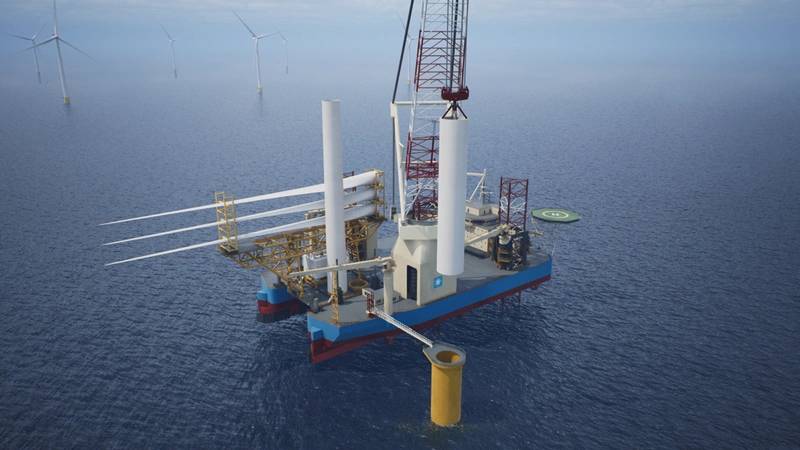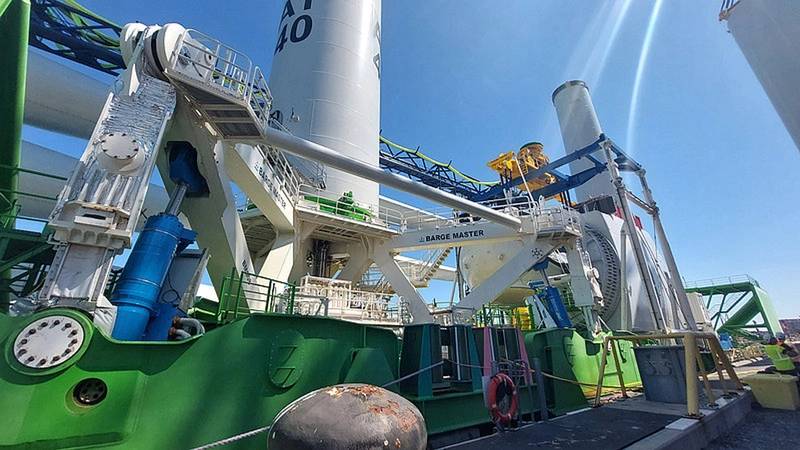
With clean energy projects maturing in U.S. waters, the nation’s offshore wind industry is poised to grow substantially, requiring a robust industrial base. A feedering model using domestic tugs and barges to transport turbines to offshore wind sites, is positioned at the heart of this emerging growth.
Currently, the entire global fleet of wind turbine installation vessels (WTIV)—except for Dominion Energy’s Charybdis currently under construction at the Seatrium AmFELS yard in Brownsville, Texas—is flagged, owned and operated outside of the U.S. Because of the Jones Act, which limits the transport of marine cargos from U.S. points to vessels that are domestically built, owned and crewed, foreign WTIVs are unable to pick up wind turbine components from shore to install them offshore.
During the construction of the United States’ first commercial wind farm off Block Island, the installation vessel used for the project picked up its components from Canadian ports. In the years since, the feedering model has emerged as perhaps the best viable method of deploying America’s offshore wind infrastructure. The model involves a close partnership between U.S. and foreign players. From U.S. ports, domestic tugs and barges carry wind turbine components to WTIVs stationed offshore.
US vs. Europe: Cost and efficiency
While there are commonalities between offshore wind installations in Europe and the U.S., they also differ markedly in regulatory regimes and operational models.
In Europe, where offshore wind has been maturing for a much longer period of time, installation projects benefit from integrated vessels that are specially equipped to handle the transport and installation of turbine components in one go. Instead of having to anchor multiple vessels and deal with the logistical complexities of a wider spread of vessels, WTIVs can receive turbines from land and then install their cargo at sea. European firms have invested in a large fleet of custom-made WTIVs—primarily built at Asian yards—to handle the increasing scale and complexity of commercial offshore wind farms.
By contrast, the U.S. offshore wind industry is much younger and is relatively constrained. To comply with domestic maritime regulations, recent projects such as South Fork and Vineyard Wind have relied on American tug-and-barge companies that ferry wind turbine components from U.S. ports, where they’re staged, to WTIVs stationed offshore. For Vineyard Wind, Foss Maritime tugs and barges transported GE turbines to DEME Offshore’s installation vessel.
 Blades are installed at the South Fork wind farm (Photo: Orsted)
Blades are installed at the South Fork wind farm (Photo: Orsted)
The all-in-one approach being employed in Europe, in general, reduces logistical complexities, lowering costs and decreasing onsite installation times. The ability to perform transport and install tasks using a single purpose-built vessel creates economies of scale and simplifies logistics while eliminating the need for multiple extra vessels and the associated cost.
Analysts have said the feedering model, on the other hand, creates additional logistical challenges and expenses, and it can even hurt productivity. More vessels are involved in completing a single installation, which can add cost and reduce overall efficiency. In addition, feeder vessels are more prone to weather disruptions, present additional risk in terms of stability and collisions, and increase the handling (and exposure to damage) of delicate components.
In the U.S. context, where no U.S.-built WTIVs are presently available, the added costs and challenges associated with feedering are unavoidable—for now. Once operational, likely in 2025, the U.S.-built WTIV Charybdis will be able to both transport and install turbine components. But there will be challenges, including port infrastructure limitations that prevent access for large WTIVs. In addition, a sole Jones Act installation vessel cannot meet the needs of an entire industry that sees its project pipeline growing. Feedering will still be a necessity.
It’s worth noting that the feedering method also presents its own set of unique advantages. In fact, the model has been executed to great success for foundation installation for jackets, monopiles, suction bucket jackets and gravity-based structures. The model also helps to build up a U.S. maritime workforce, creating new jobs and keeping mariners employed. And it allows WTIVs to remain on-site, maximizing their time spent installing components and reducing the idle time waiting for parts to be delivered. In addition, under certain circumstances, it can serve as a workaround for port restrictions or the challenge of transporting unique foundation designs.
As such, the U.S. offshore wind industry, although it faces many ongoing challenges ahead, has a business-critical path available for implementation: the feedering model. Although this model is more complex, typically more expensive, and has a higher risk than the traditional energy supply model used for decades in many other areas of the world, it is necessary.
 Components are transported out for Vinyard Wind 1 construction (Photo: Barge Master)
Components are transported out for Vinyard Wind 1 construction (Photo: Barge Master)
Advancements in technology
One of the biggest bottlenecks in the U.S. offshore wind industry is the availability of the right kind of vessels. In particular, as offshore installation activity continues to ramp up over the coming years, more high-power offshore tugs and large deck barges will be needed. According to Spinergie, the current fleet of Jones Act compliant barges suitable for offshore wind is 167, most of which is aged at 20 years and up.
WTIV availability is also expected to present potential bottleneck challenges in the U.S. as well as European and Asian markets. Charybdis’ arrival to the Jones Act market could bolster the U.S.’s transition to a new sustainable energy sector by scaled-up offshore wind capacity, but it is only a single vessel, and many more will be needed to meet projected demand.
As the U.S. begins to scale up its domestic offshore wind energy sector, it will need to increase its fleet and ensure adequate technology is available. For example, motion compensation equipment—like the kind developed by Barge Master and used in support of Vineyard Wind 1 construction—is essential to prevent large components of wind turbines from becoming unstable when lifted from a barge to a WTIV, especially in a harsh offshore environment.
To help address the challenge of lifting turbine components from a moving barge, Friede & Goldman has developed the BargeRACK concept. The ABS-approved system uses a trussed rack fitted to the transom of a self-elevating vessel to lift feeder barges out of the water, thereby eliminating motions between the installation vessel and the barge while lifting and installing wind turbine components, reducing risk and increasing safety. COSCO Shipping has reportedly entered into an agreement to build a WTIV compatible with this technology.
Another new concept has emerged that allows purpose-built barges to connect into a specially designed jackup WTIV via a locking mechanism that stabilizes the barge. Leveraging this innovation, the Maersk Sturgeon WTIV will be built by Seatrium in Singapore and used in turbine installation in the U.S. Northeast. According to Maersk, the solution can delivery up to 30% productivity gains.
 Maersk’s new Sturgeon WTIV concept promises efficiency gains. (Photo: Maersk)
Maersk’s new Sturgeon WTIV concept promises efficiency gains. (Photo: Maersk)
Environmental considerations
With the growing scale of the offshore wind market, there is an increasing focus on reducing the industry's environmental impact. Although wind farms produce zero-carbon energy, building and installing them still take their ecological toll. Once again, the higher carbon footprint of the feedering model – involving numerous vessels – contrasts sharply with the European design, which is closely integrated and utilizes fewer ships.
To keep it cleaner, offshore wind developers are also looking into greener technologies for tugs, barges, and WTIVs – namely, hybrid or electric propulsion systems, and alternative fuels such as methanol for the installation vessels – and how those can help drive down the emissions associated with ferrying components out to the wind turbines. Moreover, developers are also starting to consider emissions over the whole lifecycle of a wind farm. This means considering the energy (as well as materials and manpower) required to sustain wind farms year after year. The industry will need to invest in greener technologies and more efficient vessel operations to make a significant dent in its environmental footprint.
 Barge Master heavy feeder with tower section (Photo: Barge Master)
Barge Master heavy feeder with tower section (Photo: Barge Master)
Lessons learned and expanding capacity
Early U.S. offshore wind projects have offered invaluable lessons about planning for the future: how vessels (and their drivers) and installation teams communicate and react to unforeseen weather and timing delays, miscommunication or equipment failures.
Among the more challenging of these issues is the availability of vessels. It is one of the areas in which Europe has advantages over the U.S. due to its decades of experience developing offshore wind. The U.S. currently has a fraction of the WTIV and barge capacity it will need. With each new project scheduled to open, the risk of bottlenecks associated with multiple projects competing for a limited number of vessels increases. The U.S. needs to invest in domestic shipbuilding and a fleet (tugs, barges and WTIVs, among other vessels) to match.
In the near term, the feedering model will continue to be a vital component in the U.S. offshore wind supply chain. With only one WTIV currently under construction in the U.S., offshore wind developers can expect to rely on feedering with a foreign-flagged WTIV for installation.
While the cost and efficiency challenges of the feedering model are high and urgent, the financial and operational levers to address these issues and to improve the model are just as numerous, and targeted investments in vessel capacity, new technologies and environmental sustainability will be critical to the continued success of the rapidly growing U.S. offshore wind industry.
Meanwhile, in the longer term, as more U.S.-built WTIVs potentially come online, the U.S. may eventually migrate toward a more vertically integrated model similar to Europe’s. To date, there have been no further WTIV builds announced in the U.S. So, for now, feedering is likely to be the backbone of U.S. offshore wind development, helping to bring the country’s ambitious clean energy targets within reach.